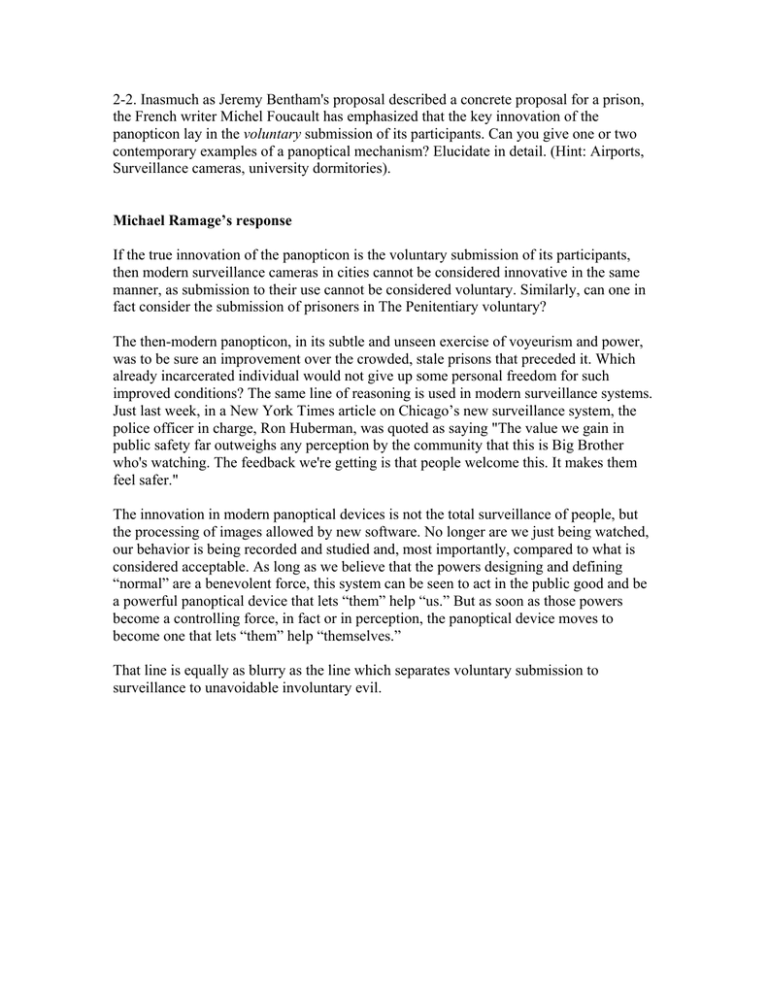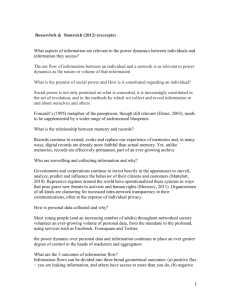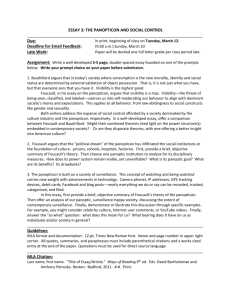2-2. Inasmuch as Jeremy Bentham's proposal described a concrete proposal... the French writer Michel Foucault has emphasized that the key...
advertisement

2-2. Inasmuch as Jeremy Bentham's proposal described a concrete proposal for a prison, the French writer Michel Foucault has emphasized that the key innovation of the panopticon lay in the voluntary submission of its participants. Can you give one or two contemporary examples of a panoptical mechanism? Elucidate in detail. (Hint: Airports, Surveillance cameras, university dormitories). Michael Ramage’s response If the true innovation of the panopticon is the voluntary submission of its participants, then modern surveillance cameras in cities cannot be considered innovative in the same manner, as submission to their use cannot be considered voluntary. Similarly, can one in fact consider the submission of prisoners in The Penitentiary voluntary? The then-modern panopticon, in its subtle and unseen exercise of voyeurism and power, was to be sure an improvement over the crowded, stale prisons that preceded it. Which already incarcerated individual would not give up some personal freedom for such improved conditions? The same line of reasoning is used in modern surveillance systems. Just last week, in a New York Times article on Chicago’s new surveillance system, the police officer in charge, Ron Huberman, was quoted as saying "The value we gain in public safety far outweighs any perception by the community that this is Big Brother who's watching. The feedback we're getting is that people welcome this. It makes them feel safer." The innovation in modern panoptical devices is not the total surveillance of people, but the processing of images allowed by new software. No longer are we just being watched, our behavior is being recorded and studied and, most importantly, compared to what is considered acceptable. As long as we believe that the powers designing and defining “normal” are a benevolent force, this system can be seen to act in the public good and be a powerful panoptical device that lets “them” help “us.” But as soon as those powers become a controlling force, in fact or in perception, the panoptical device moves to become one that lets “them” help “themselves.” That line is equally as blurry as the line which separates voluntary submission to surveillance to unavoidable involuntary evil. Katherine James One peculiar version of the panoptical device in modern society is the “Your Speed is…” roadside sign. This sign, by reflecting one’s speed, essentially performs the same function as the dashboard speedometer, but externally and on a very large scale. The strange dichotomy of this device is that it works as an indicator of police omnipresence while simultaneously being an exact replacement of that (human) presence. (One never sees a police officer next to the sign, as the two are redundant). The panopticon here, the “all-seeing eye,” induces voluntary behavior modification by making drivers understand the external recognition of their speed. Even beyond recognition, the driver’s behavior is also judged through the juxtaposition of the actual speed limit and the “Your Speed” reading. All of this takes place with full knowledge of the lack of human police presence, one that could cause ramifications for misbehaviors. The sign can’t take action beyond reflecting behaviors, yet people consistently slow down in its presence. In this way, the sign acts like a shadow the prisoner in the Panopticon prison would see his own misbehavior in. He thereby realizes that this behavior is also seen by others and exposed to judgment. In the Panopticon prison, it is a moot point whether the police are actually present in the shadow or not—the fact that they could be is the behavior-guiding principal. With the road sign, the driver is actually quite certain that the police eyes are not present, but the machine is so powerful an indicator of monitoring, that behavior is modified nonetheless. Interestingly, a car radar detector- a seeming way out of the panoptical trap, makes no distinction between an actual police officer monitoring speed and the sign doing the same. This goes to show that devices can fool other devices, and that in fact there is no difference in the monitoring technique and procedure. The difference is the implied consequence. However, this difference seems completely irrelevant in terms of the effectiveness of the behavior modification. The Voting Booth Catherine Fowlkes Michel Foucault’s reading and analysis of Jeremy Bentham’s panopticon focused in on the voluntary submission aspect of the design. His observations align with a contemporary society rampant with panoptical mechanisms in our physical space and in cyberspace. One many-layered example of a contemporary panoptical mechanism is the voting booth. Physically, it is an individualized space – designed for, and not allowed to be occupied by more than, one person. The body that uses it is well documented through registration of sex, name, location and beliefs (party affiliation), and thus becomes highly individualized. By engaging in the act of voting, an individual is voluntarily submitting themselves to surveillance on several levels. Though they are sequestered from other voters, they are assuming the gaze of a higher authority. This gaze is not direct – it is in fact invisible to them - but it is implicit that their actions will eventually be viewed at a removed place and time and will have repercussions. The time and place of this viewing and documenting is not known, but the individual’s behavior – that of voting – assumes that this viewing will take place. Aside from the space of the voting booth, voting itself is the ultimate act of self regulation. It is engaging in the system of government and discourse that exercises authority. It doesn’t just engage this system of authority, but supports it, perpetuates it, shapes it, advocates it, demands it. A rejection of this notion would not be to vote for a radical candidate or government, but rather to not register to vote, to not show up and not be accounted for. A voting society is a society that asks to be self regulated and has faith that this surveillance is working. A demonstration of this faith was illustrated by the outrage of Florida voters in the last Presidential election when their actions were not accounted for – when they realized no one was watching them. Spyware Elizabeth Nguyen In Discipline & Punish: The Birth of the Prison Michel Foucault emphasizes that the voluntary submission of its participants is the key innovation of the Jeremy Bentham’s Panopticon prison architecture. This submission through fear of surveillance is also true of how we use our electronic communications today. Surveillance of the internet is more insidious than the Panopticon however, for instead of suppressing communication through separation of the subjects, it the surveillance of an intensely communicative apparatus which allows for the separation of the collective crowd into a collection of separated and controlled individualities. In this comparison, the internet is not the new technology; but rather it is the development of increasingly sophisticated “spyware” that is used to monitor individual behavior for political, military, and commercial enterprises. According to Foucault, it is the formation of a body of knowledge that is highly specific to the individual that allows both the growth of control over masses of people and the mutually dependent growth of capital. Products advertised as “data security and management tools” allow managers to track keystrokes, email messages, and chat discussions within the private sphere of the office, thus improving the efficiency of the workers. The FBI’s “leaked” memos regarding it’s ability to install spyware via an email virus, as well as the legalization of it’s email and URL tracking software known as CARNIVORE in the Patriot Act of the U.S. Congress, is part of an overall scare tactic to curb the use of the networked communication devices in the service of political protests that occurs today on a global scale (for example, in 2003 the global “day” of protests against the U.S. invasion of Iraq). Spyware may also be used by corporations to track the access of URL’s of anyone who visits a particular website and allows “cookies” to be installed. The food metaphors for data collection are indicative of the insatiable appetite for more knowledge, which in turn allows more control. For example, a cookie may instruct a website as to which advertisements you will be shown when you access the site at a later date. Through the above examples, three specific criteria Foucault establishes relate closely with the functioning of internet surveillance by the state and commercial enterprise. These are 1) obtain the exercise of power at the lowest cost – economically and politically through its discretion and relative invisibility; 2) bring the effects of this social power to maximum intensity and extend them as far as possible; and 3) link this growth of power with the institutional apparatuses (in this case, commercial enterprise and state control). However, just as Bentham brought light and individual separation to a previously dungeon-based imprisonment system in order to improve discipline, the strategies for internet surveillance must allow communication among the masses. What was once a weakness now becomes the means to expose criminal and/or unethical activity or political dissent. We have come to describe the accumulation of knowledge as the Information Age. In a democratic sense, this term connotes the dissemination of power to the masses, but the new technologies of spyware allow for the inverse centralization of power through vast repositories of knowledge in the service of commercial growth and state control.


